 设计模式 - 结构型适配器模式
设计模式 - 结构型适配器模式
# 基本介绍
在现实生活中,经常出现两个对象因接口不兼容而不能在一起工作的实例,这时需要第三者进行适配。例如,讲中文的人同讲英文的人对话时需要一个翻译,用直流电的笔记本电脑接交流电源时需要一个电源适配器,用计算机访问照相机的 SD 内存卡时需要一个读卡器等。
在软件设计中也可能出现:需要开发的具有某种业务功能的组件在现有的组件库中已经存在,但它们与当前系统的接口规范不兼容,如果重新开发这些组件成本又很高,这时用适配器模式能很好地解决这些问题。
适配器模式(Adapter Pattern)将某个类的接口转换成客户端期望的另一个接口表示,主的目的是兼容性,让原本因接口不匹配不能一起工作的两个类可以协同工作。其别名为包装器(Wrapper)。
适配器模式属于结构型模式,主要分为三类:类适配器模式、对象适配器模式、接口适配器模式。
主要优点
- 客户端通过适配器可以透明地调用目标接口
- 复用了现存的类,程序员不需要修改原有代码而重用现有的适配者类
- 将目标类和适配者类解耦,解决了目标类和适配者类接口不一致的问题
- 在很多业务场景中符合开闭原则
主要缺点
- 适配器编写过程需要结合业务场景全面考虑,可能会增加系统的复杂性
- 增加代码阅读难度,降低代码可读性,过多使用适配器会使系统代码变得凌乱
# 模式的结构
适配器模式(Adapter)包含以下主要角色:
- 目标(Target)接口:当前系统业务所期待的接口,它可以是抽象类或接口
- 适配者(Adaptee)类:它是被访问和适配的现存组件库中的组件接口
- 适配器(Adapter)类:它是一个转换器,通过继承或引用适配者的对象,把适配者接口转换成目标接口,让客户按目标接口的格式访问适配者
# 工作原理
适配器模式:将一个类的接口转换成另一种接口,让原本接口不兼容的类可以兼容
从用户的角度看不到被适配者,是解耦的
用户调用适配器转化出来的目标接口方法,适配器再调用被适配者的相关接口方法
用户收到反馈结果,感觉只是和目标接口交互,如图

# 现实生活中的适配器例子
泰国插座用的是两孔的(欧标),可以买个多功能转换插头 (适配器) ,这样就可以使用了。

# 类适配器模式
# 类适配器模式介绍
基本介绍:Adapter 类,通过继承 被适配类,实现 适配接口,完成被适配类到适配接口的适配。
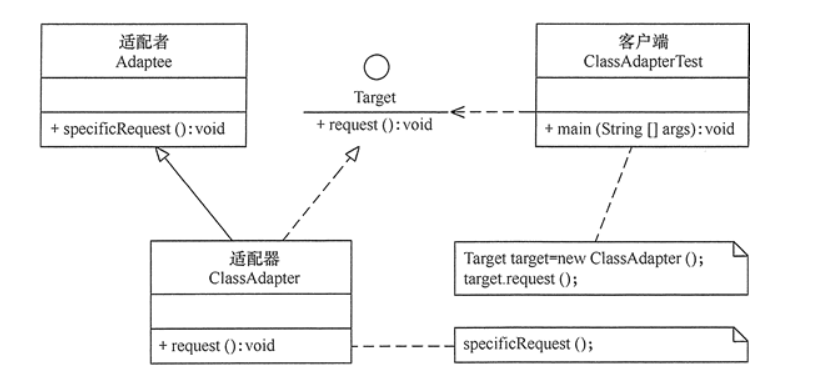
# 类适配器模式应用实例
应用实例说明:以生活中充电器的例子来讲解适配器,充电器本身相当于 Adapter,220V 交流电相当于 src(即被适配者),我们的目标是 5V 直流电。
思路分析(类图):
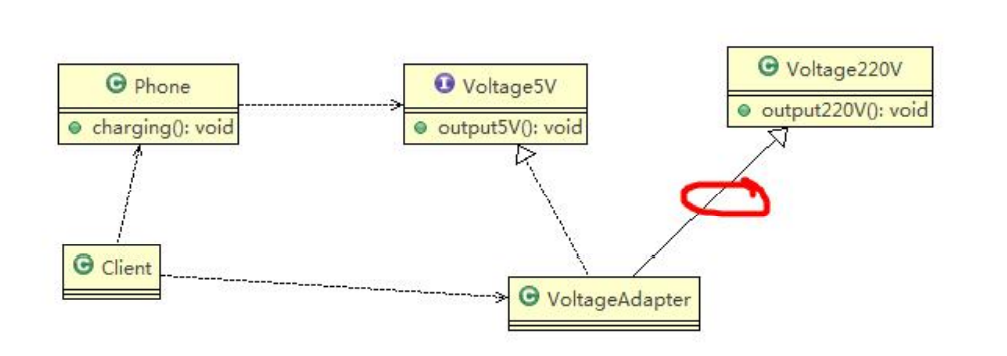
代码实现
// dst 适配接口(充电器需要 5V)
public interface IVoltage5V {
public int output5V();
}
// 被适配的类(插排的 220V)
public class Voltage220V {
// 输出 220V 的电压
public int output220V() {
int src = 220;
System.out.println("电压=" + src + "伏");
return src;
}
}
// 适配器类(充电器)需要将插排的 220V 转为实际需要的 5V
public class VoltageAdapter extends Voltage220V implements IVoltage5V {
@Override
public int output5V() {
// 获取到 220V 电压
int srcV = output220V();
int dstV = srcV / 44 ; // 转成 5v
return dstV;
}
}
2
3
4
5
6
7
8
9
10
11
12
13
14
15
16
17
18
19
20
21
22
23
24
25
手机类和测试类
public class Phone {
// 充电
public void charging(IVoltage5V iVoltage5V) {
if(iVoltage5V.output5V() == 5) {
System.out.println("电压为5V, 可以充电~~");
} else if (iVoltage5V.output5V() > 5) {
System.out.println("电压大于5V, 不能充电~~");
}
}
}
public class Client {
public static void main(String[] args) {
System.out.println(" === 类适配器模式 ====");
Phone phone = new Phone();
phone.charging(new VoltageAdapter());
}
}
2
3
4
5
6
7
8
9
10
11
12
13
14
15
16
17
18
# 类适配器模式注意事项和细节
- Java 是单继承机制,所以类适配器需要继承 src(被适配类)类这一点算是一个缺点,因为这要求 dst(适配接口) 必须是接口,有一定局限性
- src 类的方法在 Adapter 中都会暴露出来,也增加了使用的成本
- 由于其继承了 src 类,所以它可以根据需求重写 src 类的方法,使得 Adapter 的灵活性增强了
# 对象适配器模式
# 对象适配器模式介绍
基本思路和类的适配器模式相同,只是将 Adapter 类作修改,不是继承 src 类,而是持有 src 类的实例,以解决兼容性的问题。即:持有 src 类,实现 dst 类接口,完成 src 到 dst 的适配。
根据「合成复用原则」,在系统中尽量使用 关联关系(聚合)来替代继承 关系。
对象适配器模式是适配器模式常用的一种。
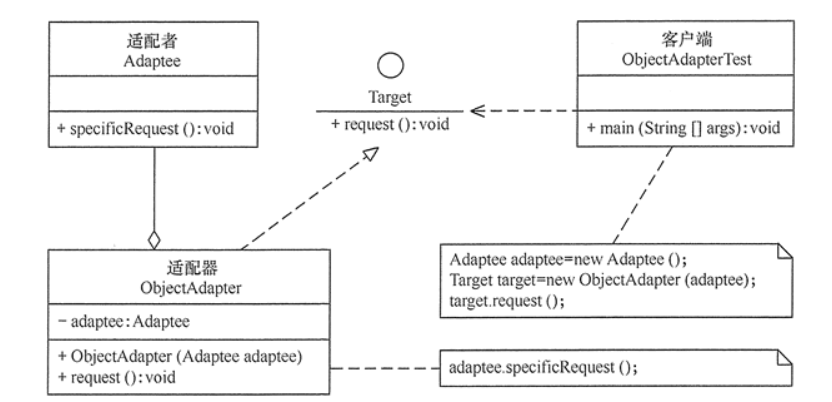
# 对象适配器模式应用实例
应用实例说明
以生活中充电器的例子来讲解适配器,充电器本身相当于 Adapter,220V 交流电相当于 src (即被适配者),我们的 dst(即目标)是 5V 直流电,使用对象适配器模式完成。
思路分析(类图)
只需修改适配器即可,如下:
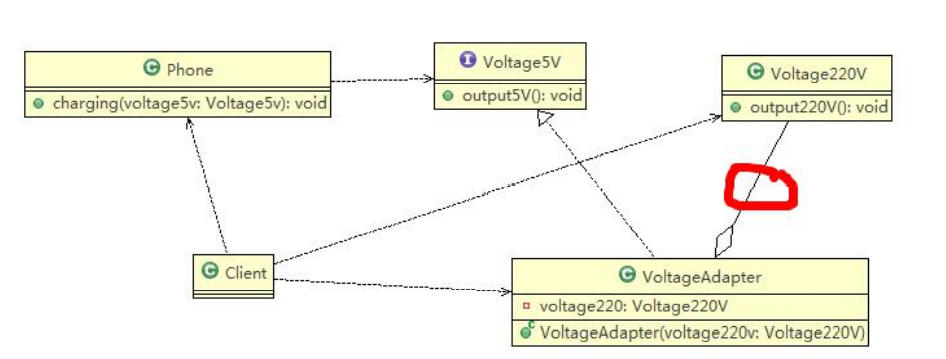
代码实现
// 适配接口(充电器需要 5V)
public interface IVoltage5V {
public int output5V();
}
// 被适配的类(插排的 220V)
public class Voltage220V {
// 输出 220V 的电压,不变
public int output220V() {
int src = 220;
System.out.println("电压=" + src + "伏");
return src;
}
}
// 适配器类(充电器)需要将插排的 220V 转为实际需要的 5V
public class VoltageAdapter implements IVoltage5V {
private Voltage220V voltage220V; // 关联关系-聚合
// 通过构造器,传入一个 Voltage220V 实例
public VoltageAdapter(Voltage220V voltage220v) {
this.voltage220V = voltage220v;
}
@Override
public int output5V() {
int dst = 0;
if(null != voltage220V) {
int src = voltage220V.output220V(); //获取 220V 电压
System.out.println("使用对象适配器,进行适配~~");
dst = src / 44;
System.out.println("适配完成,输出的电压为=" + dst);
}
return dst;
}
}
2
3
4
5
6
7
8
9
10
11
12
13
14
15
16
17
18
19
20
21
22
23
24
25
26
27
28
29
30
31
32
33
34
35
36
37
手机类和测试类
public class Phone {
// 充电
public void charging(IVoltage5V iVoltage5V) {
if(iVoltage5V.output5V() == 5) {
System.out.println("电压为5V, 可以充电~~");
} else if (iVoltage5V.output5V() > 5) {
System.out.println("电压大于5V, 不能充电~~");
}
}
}
public class Client {
public static void main(String[] args) {
System.out.println(" === 对象适配器模式 ====");
Phone phone = new Phone();
phone.charging(new VoltageAdapter(new Voltage220V()));
}
}
2
3
4
5
6
7
8
9
10
11
12
13
14
15
16
17
# 对象适配器模式注意事项和细节
对象适配器和类适配器其实算是同一种思想,只不过实现方式不同。根据合成复用原则,使用组合替代继承,所以它解决了类适配器必须继承 src 的局限性问题,也不再要求 dst 必须是接口
使用成本更低,更灵活
# 接口适配器模式
# 接口适配器模式介绍
- 一些书籍称为:适配器模式(Default Adapter Pattern)或缺省适配器模式
- 核心思路:当不需要全部实现接口提供的方法时,可先设计一个抽象类实现接口,并为该接口中每个方法提供一个默认实现(空方法),那么该抽象类的子类可有选择地覆盖父类的某些方法来实现需求
- 适用于一个接口不想使用其所有的方法的情况
# 接口适配器模式应用实例
Android 中的属性动画 ValueAnimator 类可以通过
addListener(AnimatorListener listener)方法添加监听器,那么常规写法如下:ValueAnimator valueAnimator = ValueAnimator.oflnt(0, 100); valueAnimator.addListener(new Animator.AnimatorListener() { @Override public void onAnimationStart(Animator animation) {} @Override public void onAnimationEnd(Animator animation) {} @Override public void onAnimationCancel(Animator animation) {} @Override public void onAnimationRepeat(Animator animation) {} }); valueAnimator.start();1
2
3
4
5
6
7
8
9
10
11
12有时候我们不想实现
Animator.AnimatorListener接口的全部方法,我们只想监听 onAnimationStart,我们会如下写:ValueAnimator valueAnimator = ValueAnimator.oflnt(0,100); valueAnimator.addListener(new AnimatorListenerAdapter(){ @Override public void onAnimationStart(Animator animation) { // xxxx 具体实现 } }); valueAnimator.start(;1
2
3
4
5
6
7
8AnimatorListenerAdapter 类,就是一个接口适配器,代码如下:它空实现了 Animator.AnimatorListener 类(src)的所有方法
public abstract class AnimatorListenerAdapter implements Animator.Animator extends Animator.AnimatorPauseListener { @Override // 默认实现 public void onAnimationCancel(Animator animation) {} @Override public void onAnimationEnd(Animator animation) {} @Override public void onAnimationRepeat(Animator animation) {} @Override public void onAnimationStart(Animator animation) {} @Override public void onAnimationPause(Animator animation) {} @Override public void onAnimationResume(Animator animation) {} }1
2
3
4
5
6
7
8
9
10
11
12
13
14AnimatorListener 是一个接口:
public static interface AnimatorListener { void onAnimationStart(Animator animation); void onAnimationEnd(Animator animation); void onAnimationCancel(Animator animation); void onAnimationRepeat(Animator animation); }1
2
3
4
5
6程序里的匿名内部类就是 Listener 具体实现类
new AnimatorListenerAdapter(){ @Override public void onAnimationStart(Animator animation) { // xxxx 具体实现 } }1
2
3
4
5
6
案例说明
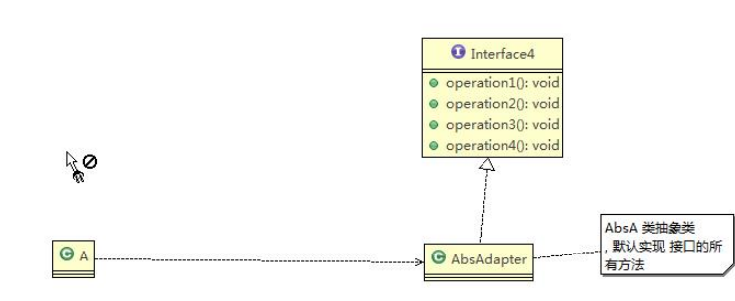
public interface Interface4 {
public void m1();
public void m2();
public void m3();
public void m4();
}
// 在 AbsAdapter 我们将 Interface4 的方法进行默认实现
public abstract class AbsAdapter implements Interface4 {
// 默认实现
public void m1() {
}
public void m2() {
}
public void m3() {
}
public void m4() {
}
}
2
3
4
5
6
7
8
9
10
11
12
13
14
15
16
17
18
19
20
21
22
23
24
25
26
测试类:
public class Client {
public static void main(String[] args) {
AbsAdapter absAdapter = new AbsAdapter() {
// 只需要去覆盖我们 需要使用 接口方法
@Override
public void m1() {
System.out.println("使用了m1的方法");
}
};
absAdapter.m1();
}
}
2
3
4
5
6
7
8
9
10
11
12
# SpringMVC 的适配器模式剖析
SpringMVC 中的 HandlerAdapter, 就使用了适配器模式
SpringMVC 处理请求的流程回顾
使用 HandlerAdapter 的原因分析:
可以看到处理器的类型不同,有多重实现方式,那么调用方式就不是确定的,如果需要直接调用 Controller 方法,需要调用的时候就得不断是使用 if-else 来进行判断是哪一种子类然后执行。那么如果后面要扩展 Controller,就得修改原来的代码,这样违背了 OCP 原则。
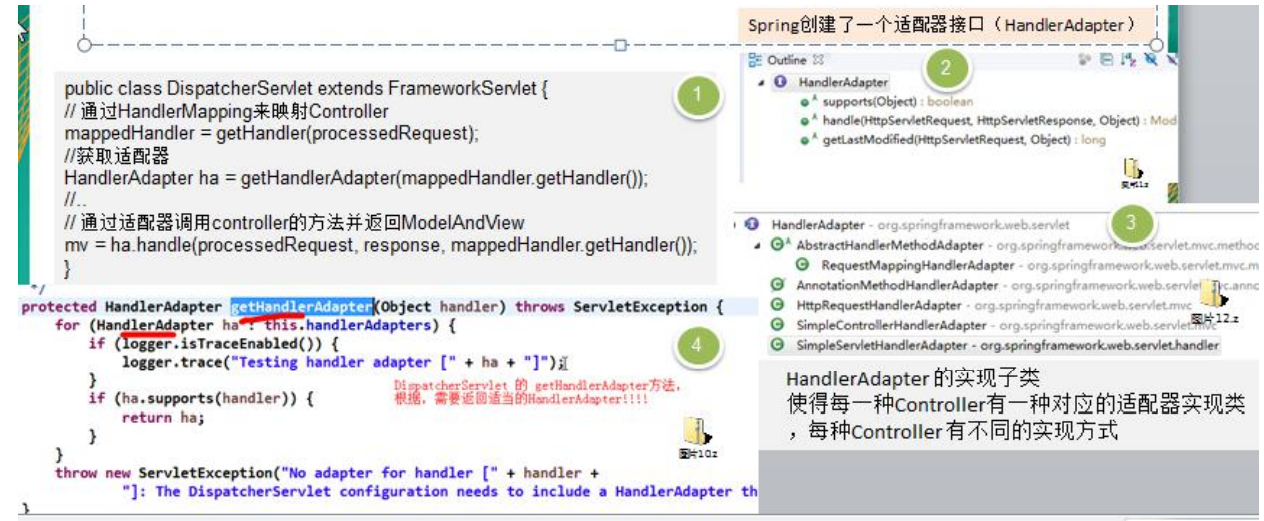
# 适配器模式的注意事项和细节
- 三种命名方式,是根据 src 是以怎样的形式给到 Adapter(在 Adapter 里的形式)来命名的
- 类适配器:以类给到,在 Adapter 里,就是将 src 当做类,继承
- 对象适配器:以对象给到,在 Adapter 里,将 src 作为一个对象,持有
- 接口适配器:以接口给到,在 Adapter 里,将 src 作为一个接口,实现
- Adapter 模式最大的作用还是将原本不兼容的接口融合在一起工作
- 实际开发中,实现起来不拘泥于我们讲解的三种经典形式
# 适配器模式的应用场景
适配器模式(Adapter)通常适用于以下场景:
- 以前开发的系统存在满足新系统功能需求的类,但其接口同新系统的接口不一致
- 使用第三方提供的组件,但组件接口定义和自己要求的接口定义不同
